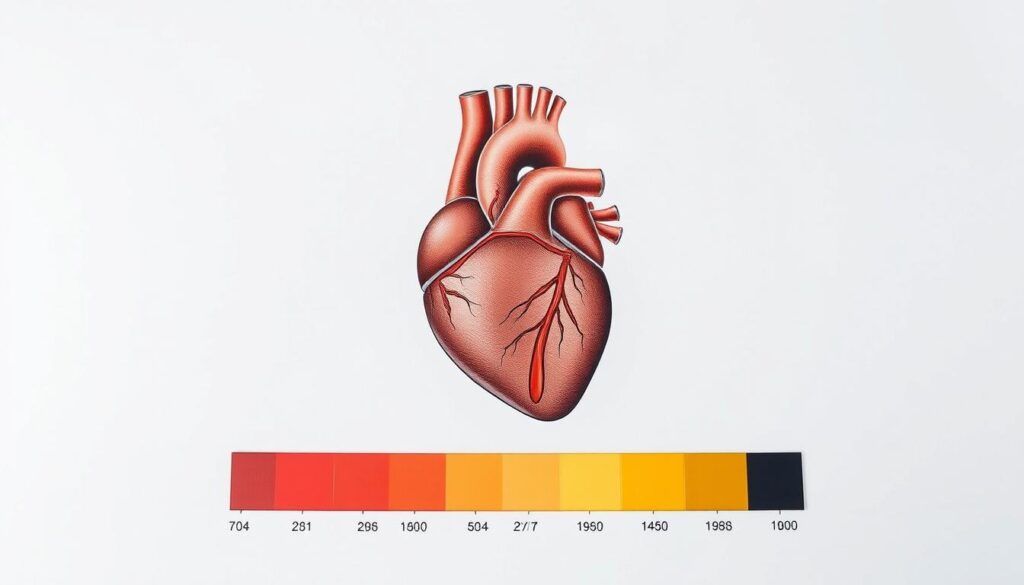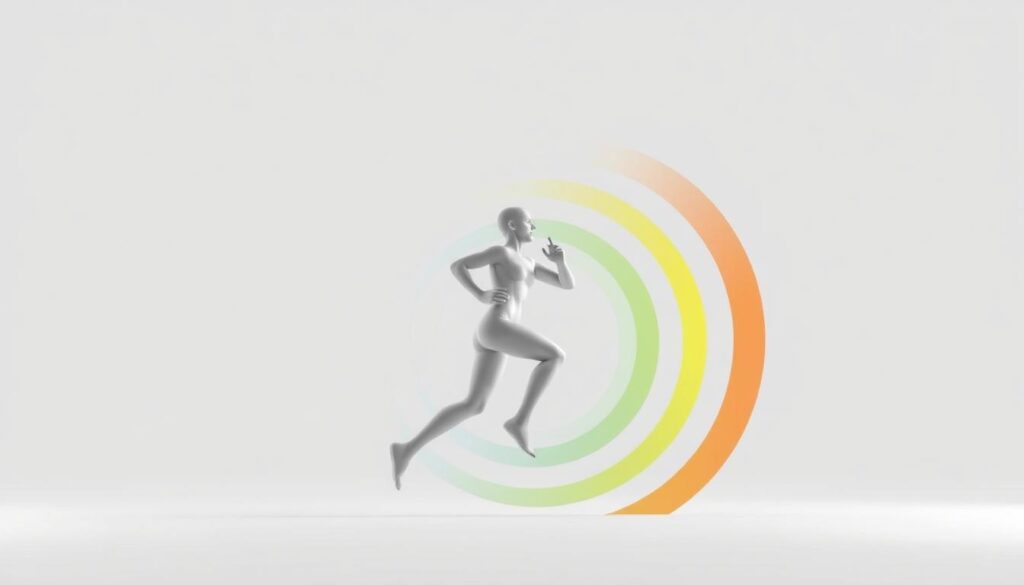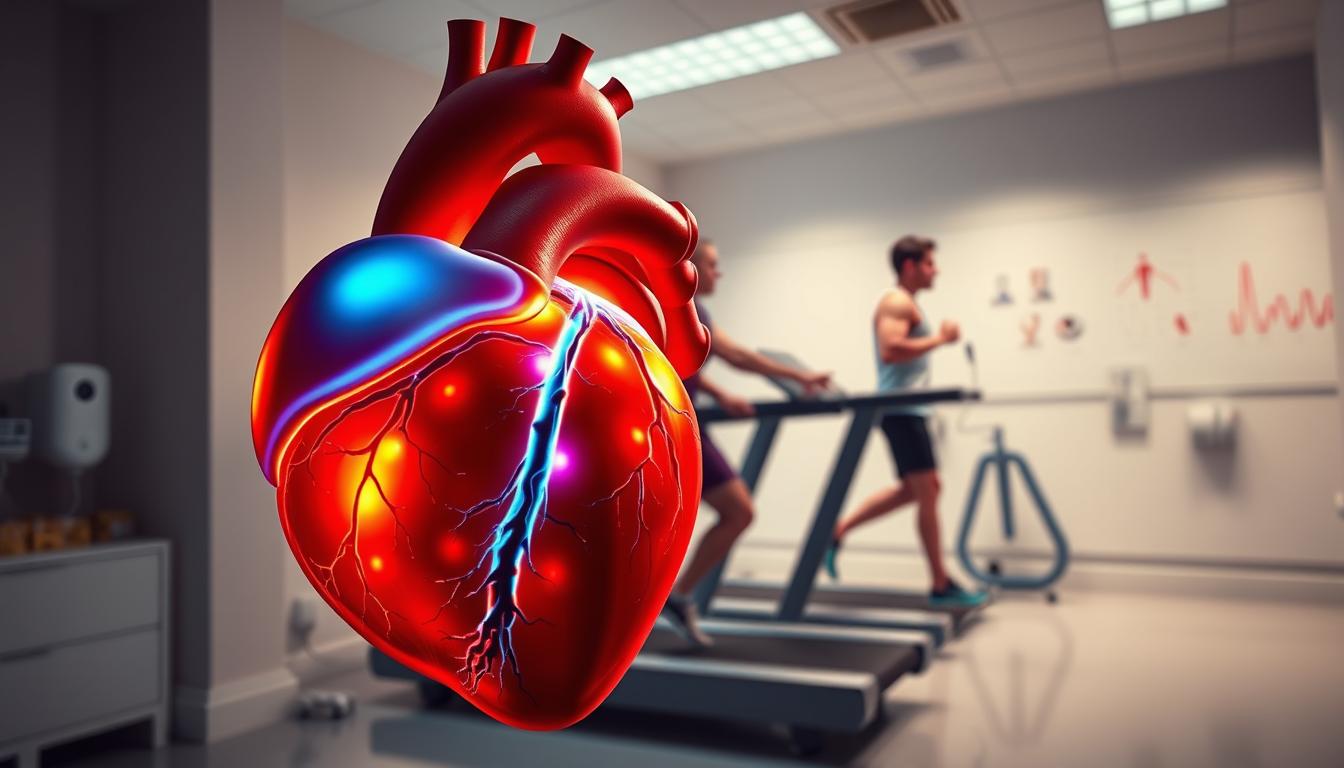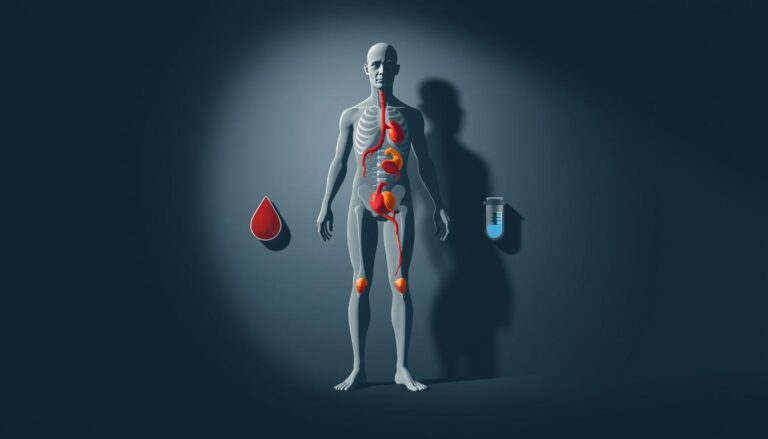Cardio: 10 Best Workouts to Boost Your Heart Health
Table of Contents
Every heartbeat tells a story of resilience. When I first discovered the transformative power of cardiovascular exercise, my perspective on health shifted dramatically. As someone who once struggled with sedentary habits, I learned that cardio is more than just movement—it’s a lifeline to vibrant living.
Regular cardiovascular exercise isn’t just a fitness trend; it’s a critical strategy for preventing heart disease. The American Heart Association recommends adults engage in at least 150 minutes of moderate-intensity aerobic activity weekly. This isn’t just a suggestion—it’s a pathway to protecting your most vital organ.
Your heart is an incredible muscle that thrives on consistent challenge. Through targeted cardio workouts, you can strengthen your cardiovascular system, improve blood circulation, and significantly reduce your risk of heart-related complications. Each workout is an investment in your long-term health and well-being.
Key Takeaways
- Cardio exercise is crucial for preventing heart disease
- Aim for 150 minutes of moderate-intensity activity weekly
- Cardiovascular workouts improve overall health and circulation
- Heart health is directly linked to consistent physical activity
- Exercise can be adapted to individual fitness levels
Understanding Heart Health and Exercise Benefits
Cardio exercises are a powerful tool for transforming your overall health and well-being. Your heart is a muscle that thrives on consistent movement and challenge. By engaging in regular aerobic fitness activities, you can dramatically improve your cardiovascular system’s performance and resilience.
Understanding the profound impact of exercise on your body starts with recognizing how different physical activities contribute to heart health. Endurance training does more than just burn calories – it rebuilds and strengthens your entire cardiovascular infrastructure.
Impact on Cardiovascular System
Regular physical activity creates remarkable changes within your cardiovascular system. The American Heart Association highlights that consistent exercise improves blood circulation, reduces arterial stiffness, and enhances heart muscle efficiency.
- Strengthens heart muscle
- Improves blood flow
- Reduces resting heart rate
- Enhances oxygen delivery to tissues
Key Health Markers Improved by Exercise
Fat-burning activities do more than shed pounds – they optimize critical health indicators. Regular cardiovascular exercise can positively influence multiple health markers:
- Lower blood pressure
- Reduced cholesterol levels
- Improved insulin sensitivity
- Enhanced mental health
Recommended Activity Levels
The American Heart Association recommends adults engage in at least 150 minutes of moderate-intensity aerobic exercise weekly. This translates to about 30 minutes of activity five days a week, making heart health both achievable and flexible.
“Your heart is your body’s most important muscle – treat it with consistent, purposeful movement.” – Cardiovascular Health Expert
By integrating diverse cardiovascular activities into your routine, you create a comprehensive approach to heart health that adapts to your lifestyle and fitness goals.
To get better results, you can benefit from the benefits of this nutritional supplement
Finding Your Target Heart Rate Zone

Knowing your target heart rate is key for good cardio workouts. It tells you how hard you’re working and keeps you safe. It’s like a real-time guide to your fitness.
To find your target heart rate, subtract your age from 220. Then, you can see your best exercise zones:
- Moderate Intensity Zone: 50-70% of maximum heart rate
- Vigorous Intensity Zone: 70-85% of maximum heart rate
Each age group has its own heart rate range. Here’s a detailed look:
| Age | Max Heart Rate | Moderate Zone | Vigorous Zone |
|---|---|---|---|
| 20 | 200 bpm | 100-140 bpm | 140-170 bpm |
| 35 | 185 bpm | 93-130 bpm | 130-157 bpm |
| 50 | 170 bpm | 85-119 bpm | 119-145 bpm |
| 65 | 155 bpm | 78-108 bpm | 108-132 bpm |
To keep track of your heart rate, you can:
- Do manual pulse checks
- Use heart rate monitors
- Wear fitness trackers
- Try smartphone apps
Keep in mind, everyone’s fitness level is different. Athletes might have lower heart rates, while beginners might have higher ones. Always talk to a doctor before starting a new workout plan.
Cardio Workouts for Maximum Heart Benefits
To boost your heart health, it’s important to know how to do cardio right. Choosing the right workout intensity and listening to your body can change your fitness journey. Hiit cardio and treadmill workouts are great for improving heart health and fitness.

Moderate vs. Vigorous Intensity
How hard you exercise matters a lot for your heart. The American Heart Association has guidelines for heart rate zones:
- Moderate intensity: 50-70% of maximum heart rate
- Vigorous intensity: 70-85% of maximum heart rate
To find your maximum heart rate, subtract your age from 220. For example, a 30-year-old’s maximum heart rate is 190 beats per minute.
Monitoring Exercise Intensity
Keeping track of your workout intensity is key for better treadmill and hiit cardio sessions. Here are ways to measure your effort:
- Perceived exertion scale (1-10)
- Heart rate monitoring
- Talk test (ability to maintain conversation)
Safety Guidelines
Keep your heart safe while exercising with these tips:
- Warm up for 5-10 minutes before intense workouts
- Stay hydrated during exercise
- Gradually increase workout intensity
- Listen to your body and rest when needed
Remember, consistency is key for a lasting cardiovascular fitness routine.
Walking and Power Walking Techniques

Power walking turns regular walking into a great way to get your heart rate up. It’s a low-impact activity that’s good for everyone, no matter your fitness level.
To get the most out of it, power walking needs certain techniques. You should walk fast, between 4 to 5.5 miles per hour. This means you’ll cover a mile in 13 to 15 minutes.
- Maintain an upright posture with shoulders relaxed
- Swing arms naturally at a 90-degree angle
- Take shorter, quicker steps
- Land on heel and roll through to toe
Your walking speed affects how hard you’re working out. The CDC says you should do 150 minutes of moderate exercise each week. Power walking can help you meet this goal.
| Walking Intensity | Speed (mph) | Perceived Exertion |
|---|---|---|
| Moderate Walking | 3-4 | 5-6 |
| Power Walking | 4-5.5 | 7-8 |
Start with 10-minute walks and then add more time. Listen to your body and go slow to avoid getting hurt. This way, you’ll build up your endurance.
“Walking is man’s best medicine” – Hippocrates
Don’t forget to wear good shoes and stay hydrated. Enjoy your power walking and watch your heart health improve!
Running and Jogging Fundamentals
Running is a great way to boost your aerobic fitness and health. It’s perfect for beginners or those wanting to get better at running. Learning the basics is key to a safe and effective workout.
Starting a running program takes patience and planning. Beginners should follow a structured plan to build endurance and avoid injuries.
Proper Form and Breathing
Learning the right running technique is essential for a good cardio workout. Here are some important tips:
- Maintain an upright posture with slight forward lean
- Keep shoulders relaxed and arms at 90-degree angles
- Land midfoot to reduce impact on joints
- Practice rhythmic breathing synchronized with your stride
Progressive Training Methods
Here are ways to gradually increase your running:
- Start with run/walk intervals: 3 minutes running, 1 minute walking
- Increase total weekly running time by 10% each week
- Aim for consistent three to four running days per week
- Begin with 20-minute sessions, progressing to 25-30 minutes
Injury Prevention Tips
Here are tips to protect your body while running:
- Always warm up and cool down
- Stretch before and after running
- Invest in proper running shoes
- Listen to your body and rest when needed
Remember, consistency is key in developing a sustainable running practice for long-term cardio fitness.
Swimming: Low-Impact Cardio Excellence
Swimming is a top-notch cardiovascular exercise that works your whole body without putting too much strain on your joints. It’s great for everyone, no matter your fitness level. The water’s resistance helps build strength and boosts heart health.
Swimming has many benefits beyond regular workouts. It’s perfect for those with joint problems or looking for a low-impact exercise. Studies show it can burn 300 to 700 calories per hour, based on how hard you swim and your weight.
- Recommended weekly swimming duration: 2.5 hours for optimal heart health
- Water resistance is 12 times greater than air, enhancing strength training
- Supports cardiovascular health by lowering blood pressure
- Reduces stress and improves mental well-being
Different strokes in swimming offer different benefits. Freestyle works your whole body, while breaststroke targets your lower body. Beginners can start with 5-10 minute sessions and aim for 30 minutes or more as they get better.
“Swimming is not just exercise, it’s a holistic approach to physical and mental wellness.” – Fitness Expert
To get the most out of swimming, focus on good technique and keep practicing. Joining aquatic classes or getting a swim instructor can help you swim better and avoid injuries.
Cycling for Heart Health
Cycling is a great way to boost your heart health. It’s a cardio workout that helps improve your aerobic fitness and burn fat. You can cycle outdoors or on a stationary bike, both offering great benefits for your heart.
Indoor vs Outdoor Cycling Advantages
There are different ways to cycle, each with its own benefits:
- Outdoor Cycling:
- Provides natural terrain variations
- Offers vitamin D exposure
- Supports environmental engagement
- Indoor Cycling:
- Consistent workout environment
- Weather-independent training
- Precise performance tracking
Performance Metrics That Matter
Keep track of your cycling progress with important metrics:
| Metric | Importance | Target Range |
|---|---|---|
| Cadence | Pedaling rhythm | 80-100 RPM |
| Heart Rate | Cardiovascular intensity | 120-150 BPM |
| Calories Burned | Fat-burning potential | 330-818 per hour |
Resistance Training Integration
Add resistance training to your cycling routine. Interval cycling boosts your heart health and muscle strength. Mix high-intensity sprints with steady pedaling to enhance your workout.
Begin with 30-second sprints and increase the time as you get fitter. This method gives you a full-body workout that challenges your heart and muscles.
High-Intensity Interval Training (HIIT)
HIIT cardio has changed how we think about fitness. It’s a quick way to get your heart rate up and burn fat. This method involves short, intense exercises followed by rest periods. It’s a powerful way to work out.
HIIT is great because it burns fat fast, even in a short time. A 20-minute session can have big effects on your metabolism. Studies show you can keep burning calories for up to 2 hours after a HIIT workout.
- Ideal for busy individuals seeking efficient workouts
- Improves cardiovascular fitness rapidly
- Requires minimal to no equipment
- Adaptable to different fitness levels
Starters can begin with 3-4 speed intervals and increase as they get fitter. The 30-20-10 HIIT pattern is a good starting point. It includes 30 seconds of low intensity, 20 seconds of moderate, and 10 seconds of high intensity.
| Fitness Level | Weekly Sessions | Duration |
|---|---|---|
| Beginner | 2-3 sessions | 20-30 minutes |
| Intermediate | 2-4 sessions | 25-45 minutes |
| Advanced | 4-5 sessions | 45-60 minutes |
While HIIT is very beneficial, safety is key. Always warm up and cool down properly. If you have health issues, talk to a doctor before starting. Your heart rate and fitness will improve with this workout.
Resistance Training with Cardio Elements
Combining resistance training with cardio is a great way to boost your fitness. It mixes strength exercises with heart-pumping activities. This blend makes your workouts more effective and fun.
Using tools like rowing machines or elliptical trainers is key. They help you build muscle while keeping your heart rate up. These tools let you do exercises that work many muscles at once. By switching between strength and cardio, you’ll get stronger, leaner, and more fit.
Circuit Training Principles
Circuit training is perfect for mixing strength and cardio. Set up a workout with 6-8 strength exercises, resting little between each. Include bodyweight, free weights, and machine exercises to keep your heart rate high.
Equipment Options
There are many tools for a great workout at home or the gym. Kettlebells, resistance bands, dumbbells, and suspension trainers are all good choices. Pick what fits your level and helps you move smoothly between strength and cardio.
Sample Workout Routines
Here’s a sample routine: start with squats and shoulder presses, then jump rope. Next, do lunges and bicep curls, ending with mountain climbers. This keeps your body challenged and your energy high. Always increase the intensity as you get stronger.
FAQ
How often should I do cardio for optimal heart health?
The American Heart Association suggests at least 150 minutes of moderate aerobic exercise weekly. This is about 30 minutes of cardio five days a week. It greatly improves your heart health and fitness.
What is my target heart rate during exercise?
Your target heart rate varies by age and fitness. Subtract your age from 220 and aim for 50-85% of that number. For moderate, aim for 50-70%, and for vigorous, 70-85%.
Can I do cardio if I’m a beginner?
Yes, you can! Start with low-impact activities like walking, swimming, or cycling. Begin with shorter, less intense workouts and increase as you get stronger. Always check with a doctor before starting, especially if you have health issues.
What are the best cardio workouts for fat burning?
High-Intensity Interval Training (HIIT) is great for burning fat. Running, cycling, swimming, and rowing also work well. They boost your metabolism, burn calories, and improve your heart health.
How do I prevent injury during cardio workouts?
To avoid injuries, warm up well, use the right form, and wear good shoes. Stay hydrated and increase intensity slowly. Listen to your body and take rest days. Stretching and strength training help too.
Is walking an effective cardio exercise?
Yes, walking is a good cardio exercise. Power walking is especially beneficial for heart health. It’s easy, doesn’t need special gear, and fits into daily life.
How important is heart rate monitoring during exercise?
Monitoring your heart rate is key to exercising right. It keeps you in the right zone, makes workouts better, and prevents too much effort. Use pulse checks, fitness watches, or heart rate monitors to track your effort.
Can I do cardio if I have existing heart conditions?
Always talk to your doctor first. Many with heart conditions can do cardio, but it depends on your health. A cardiac rehab program can give you personalized advice.
What’s the difference between moderate and vigorous cardio?
Moderate intensity lets you talk but not sing (like brisk walking). Vigorous intensity makes talking hard (like running). Both are good, but vigorous is more intense and quicker to benefit your health.
How does cardio improve overall health beyond heart benefits?
Cardio exercise boosts sleep, reduces stress, helps with weight, increases energy, and improves mental health. It also strengthens your immune system and lowers the risk of diseases like diabetes and some cancers.







